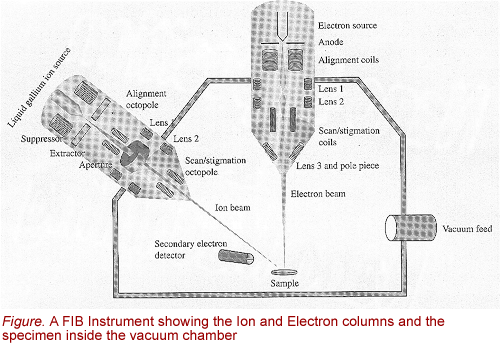 |
|
NANOTECHNOLOGY UNDERGRADUATE EDUCATION - 2007 In Situ Real-time Atomic Scale Nanostructural Synthesis, Characterization and Modeling |
Nano machines or devices require manufacturing very small parts for their construction, and extracting small specimens from them for analysis of structure and composition at the nanoscale level, to analyze performance. Focused Ion Beam (FIB) machining, which is sometimes called FIB milling, has emerged as one of the most useful methods for shaping nanomaterials after synthesis. Near net shape synthesis methods, such as photo lithographic patterning used with chemical vapor deposition, is the other primary synthesis technique. These two techniques are often complementary, and here we illustrate and describe FIB milling.
FIB milling involves removing material from a larger body to make a nanopart or specimen. Examples are nanogears (see example shown on Scale of Things chart) and specimens for transmission electron microscopy cut out from specific regions of interest in electronic nanodevices (see section on FIB Lift-Out technique).

FIB milling removes material from a part by impinging a relatively high energy focused (meaning small diameter) ion beam on the part to be milled. The kinetic energy of the ions in the beam is sufficient to knock atoms off the surface of target materials. This atom removal process is called “sputtering”, and constitutes the nanomachining operation. The position of the incident ion probe on the specimen is controlled by computer driven scanning coils. The pattern to be machined is programmed, thus quite complex shapes can be produced, and reproduced if necessary. The next question that will occur to the perceptive student is how to observe these small nanoparts as they are being machined, to gage acceptability? That is accomplished by building a scanning electron microscope into the FIB instrument, so the part can be observed at high magnification while it is being machined. The FIB instrument, then, contains two charged particle optical columns, one for positive ions and one for negative electrons. The particle sources are both field emission type, and magnetic and electrostatic lenses are used to focus both beams. Of course in principle the nanospecimen could be imaged using secondary electron emission caused by the ion beam impact, but here the specimen would be sputtered while being observed. The electron column is provided so that the specimen is not disturbed or changed in any way while being observed. The figure above shows both columns on a FIB instrument.
When ions such as gallium (symbol Ga) impact a material with enough energy to displace atoms from their normal positions in the solid (for the case of crystalline materials, from their lattice sites) a “displacement cascade” is formed. This is an ellipsoidal region in the solid containing several to hundreds of displaced atoms, depending on the energy and relative mass of the incident ions. The ellipsoid is extended along the direction of ion incidence. When the displacement cacade intersects the specimen surface, ie when the incident ion beam is hitting the specimen surface at a shallow angle, atoms are ejected from the specimen surface, and ion milling occurs. A simple energy transfer model called the linear collision cascade model explains the process in terms of binary collisions of the primary incident ion (Ga+ in our case) and the target material atoms, leading to exchange of energy and momentum between the incident ions and target atoms.
It is important to accurately model ion-solid interations for reliable calculations of sputtering yield which indicates the efficiency of the sputtering process. The nature of beam-specimen interaction is strongly influenced by the incident energy of the projectile ion as well as the mass ratio of the projectile ion to target atoms. An empirical formula proposed by Yamamura et al for calculation of sputtering yield is detailed in the next section.
| The LeRoy Eyring Center for Solid State Science PO Box 879506 Engineering Center G Wing, Room 307 Tempe, AZ 85287-9506 Office Phone: (480) 965-4544 Fax: (480) 965-9004 |
|
| Contact Webmaster |
